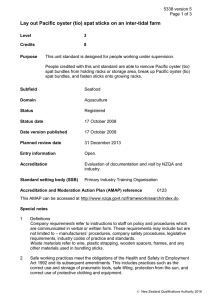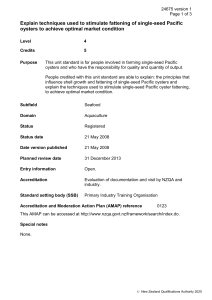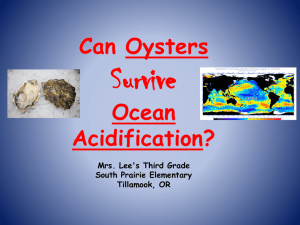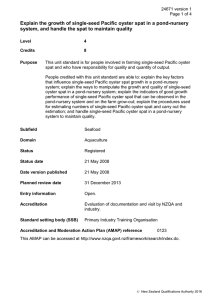Explain selective breeding and hatchery techniques associated with
advertisement
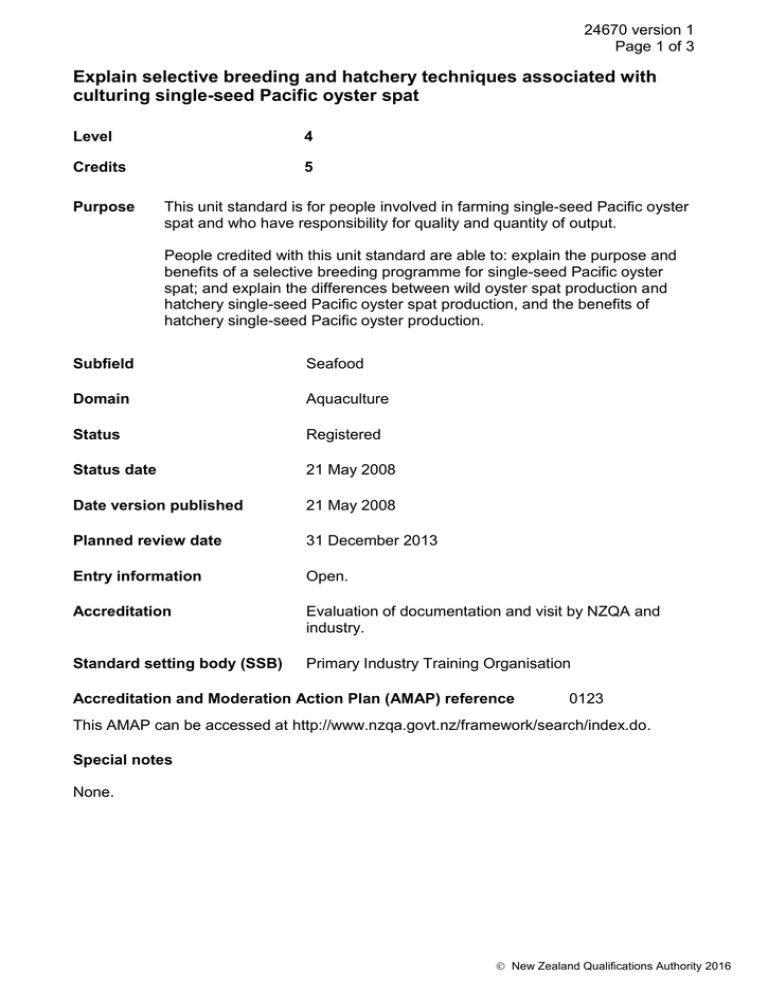
24670 version 1 Page 1 of 3 Explain selective breeding and hatchery techniques associated with culturing single-seed Pacific oyster spat Level 4 Credits 5 Purpose This unit standard is for people involved in farming single-seed Pacific oyster spat and who have responsibility for quality and quantity of output. People credited with this unit standard are able to: explain the purpose and benefits of a selective breeding programme for single-seed Pacific oyster spat; and explain the differences between wild oyster spat production and hatchery single-seed Pacific oyster spat production, and the benefits of hatchery single-seed Pacific oyster production. Subfield Seafood Domain Aquaculture Status Registered Status date 21 May 2008 Date version published 21 May 2008 Planned review date 31 December 2013 Entry information Open. Accreditation Evaluation of documentation and visit by NZQA and industry. Standard setting body (SSB) Primary Industry Training Organisation Accreditation and Moderation Action Plan (AMAP) reference 0123 This AMAP can be accessed at http://www.nzqa.govt.nz/framework/search/index.do. Special notes None. New Zealand Qualifications Authority 2016 24670 version 1 Page 2 of 3 Elements and performance criteria Element 1 Explain the purpose and benefits of a selective breeding programme for single-seed Pacific oyster spat. Performance criteria 1.1 The explanation includes the purpose for the selective breeding of single-seed Pacific oyster spat. 1.2 The explanation includes the benefits of a selective breeding programme for single-seed Pacific oyster spat, in terms of the final product. Range 1.3 includes but is not limited to – uniformity, meat quality, shell quality, marketability, growth rate. The explanation includes the benefits of a selective breeding programme for single-seed Pacific oyster spat, in terms of the farm operation. Range includes but is not limited to – handling of stock, cropping cycles. Element 2 Explain the differences between wild oyster spat production and hatchery single-seed Pacific oyster spat production, and the benefits of hatchery single-seed Pacific oyster spat production. Performance criteria 2.1 The explanation includes the differences at each step involved in producing oyster spat in a hatchery compared to production in the wild. Range 2.2 spawning, larval rearing, settlement, spat rearing. The explanation includes the benefits associated with hatchery single-seed Pacific oyster spat supply to oyster farmers. Please note Providers must be accredited by the Qualifications Authority, or an inter-institutional body with delegated authority for quality assurance, before they can report credits from assessment against unit standards or deliver courses of study leading to that assessment. Industry Training Organisations must be accredited by the Qualifications Authority before they can register credits from assessment against unit standards. Accredited providers and Industry Training Organisations assessing against unit standards must engage with the moderation system that applies to those standards. New Zealand Qualifications Authority 2016 24670 version 1 Page 3 of 3 Accreditation requirements and an outline of the moderation system that applies to this standard are outlined in the Accreditation and Moderation Action Plan (AMAP). The AMAP also includes useful information about special requirements for organisations wishing to develop education and training programmes, such as minimum qualifications for tutors and assessors, and special resource requirements. Please note Providers must be accredited by NZQA, or an inter-institutional body with delegated authority for quality assurance, before they can report credits from assessment against unit standards or deliver courses of study leading to that assessment. Industry Training Organisations must be accredited by NZQA before they can register credits from assessment against unit standards. Accredited providers and Industry Training Organisations assessing against unit standards must engage with the moderation system that applies to those standards. Accreditation requirements and an outline of the moderation system that applies to this standard are outlined in the Accreditation and Moderation Action Plan (AMAP). The AMAP also includes useful information about special requirements for organisations wishing to develop education and training programmes, such as minimum qualifications for tutors and assessors, and special resource requirements. Comments on this unit standard Please contact the Primary Industry Training Organisation standards@primaryito.ac.nz if you wish to suggest changes to the content of this unit standard. New Zealand Qualifications Authority 2016
